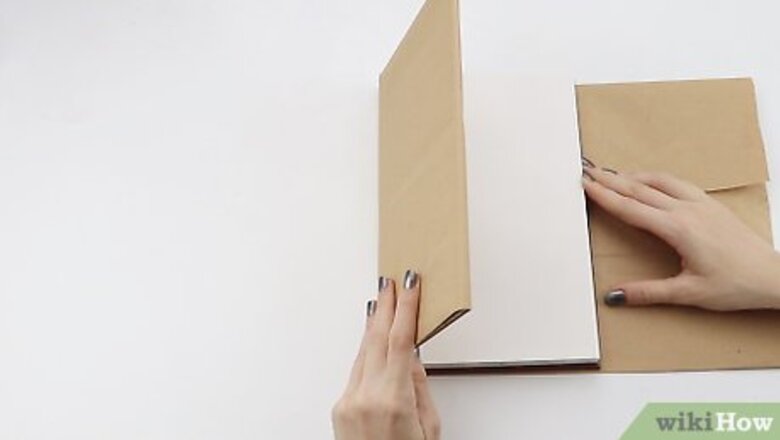
views
Making a Brown Paper Cover

Grab some brown paper, butcher paper, or a brown paper bag. All of these types of paper can make an excellent book cover. This type of cover can be left as is, or made fancier with stamping, painting or decoupaging. You could also use other papers: gift wrapping paper, photocopied design paper, and any other forms of paper that you consider strong enough to form a book cover.
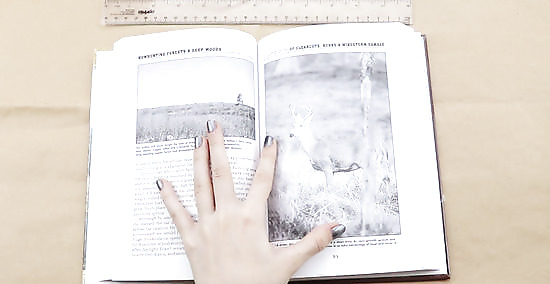
Measure the cover. Place the brown paper down on a flat work surface. Center the book on the paper. If you are using a paper bag, you will want to cut the paper bag open so that it lays flat. Remove any handles as well. Your paper should be bigger than your book so that you have enough of it to wrap around your book and create pockets for the covers to slide into.

Draw a horizontal line on the paper along the top and bottom edges of the book. Use a ruler and pencil to achieve this. This horizontal line will be your guide for folding your paper to help form your book pockets.
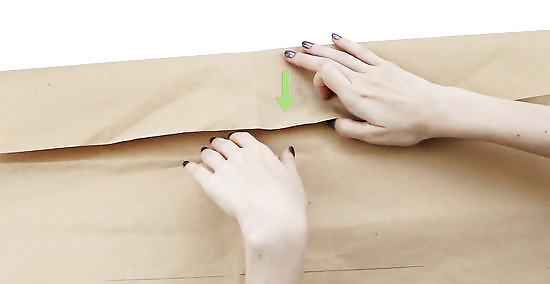
Remove the book from the paper. Fold the paper in from the top and bottom to the drawn lines. You want to crease the paper on the horizontal lines you’ve just drawn. Note that folds can be made neater and cleaner by using a bone folder. A bone folder is a piece of plastic that looks like a knife. It is used to get perfect folds and creases without cutting the paper.
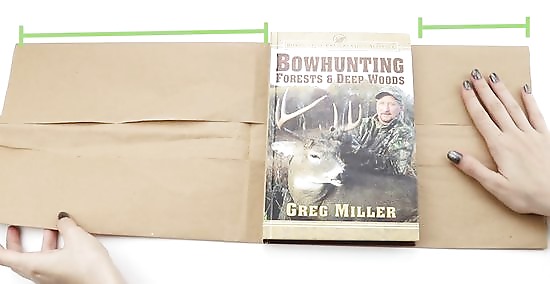
Place the book back onto the folded paper. The back of the book should be facing down onto the paper. Center the book horizontally. Make sure that the sides of the paper are of an even length on either side of the book. Then make sure you line up the book so that the top and bottom are flush with your creases.
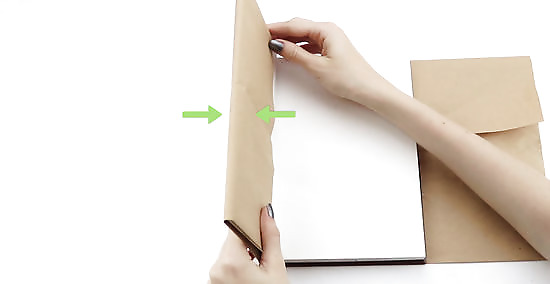
Open the front cover of the book. Fold the left edge of the paper in over the cover. With the front cover open, take the left side of your paper and fold it over the cover. If you have too much paper and the fold goes too far for your liking, cut the excess paper.
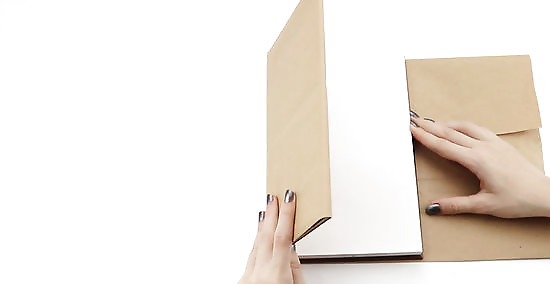
Close the book while keeping the paper folded around the cover. Keep the folded left edge of the paper tightly in position. The paper should stay wrapped snugly around the front cover. You may have to reposition the book so that you don’t rip the paper on the book’s spine. If the paper is too tight, move the book to give it more slack. You want to wrap the book without ripping the paper.
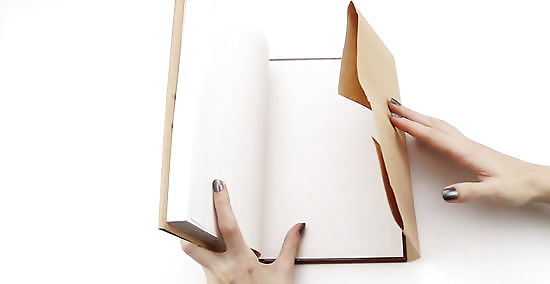
Open the back cover of the book. Fold the right edge of the paper in. Just like you did with the front cover, fold your paper over the back cover. If you have too much paper, cut some off. Close the book to make sure that the paper fits around it.
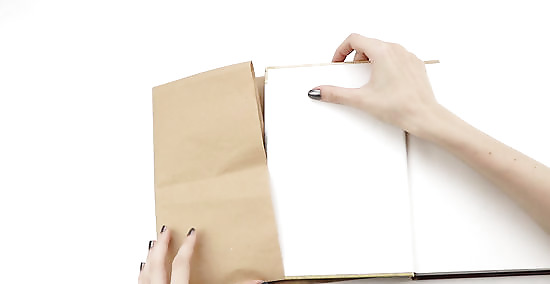
Slide each of the book’s covers into the newly created paper flaps. Do this one at a time. You’ll notice that the folds and flaps have created a pocket. You can now slide each cover into the pocket for a better hold. Provided the paper has been folded sharply and crisply, and the paper is of substantial heaviness, the cover should not need any taping down. However, you may want to tape the pocket down if you feel it necessary.
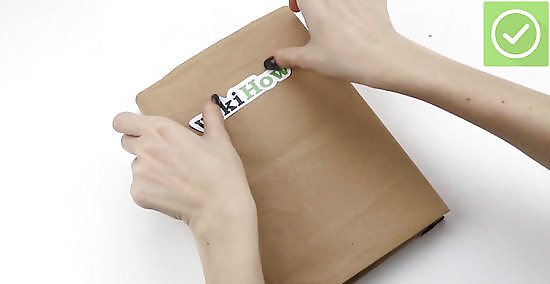
Decorate or label the book. The sky's the limit on making the brown paper more interesting. You can draw on it, potato print or paint it (do before making the book cover, though). Or stick on a label and write the name of the book inside the label space. Ribbon or braid can be glued down the spine for added effect and strength. This can be nice if the book is for a wedding, guestbook, or another memento. You can also write the name of the book, or the name of your class on the front of the paper to make it easier to differentiate.
Covering Your Book with a Plastic Cover

Grab your plastic covering. Plastic film is probably the most standard covering for a book. You can use clear or colored adhesive plastic contact paper. Or you can use various types of book covering plastic that isn’t adhesive but is made for book covering. Either type of plastic will protect your book. But, the non-adhesive method tends to be less damaging to the book in the long run. should you wish to ever remove the plastic covering, non-adhesive is easier to remove. You can also opt to make a plastic sheet protector book cover. The chemicals in the adhesive may eventually tarnish the book. Additionally, the adhesive method is not an environmentally friendly way to cover a book because recycled versions of it have not yet been created. Regular plastic coverings take a bit more work but can be easily removed. You can also try covering a book with plastic wrap. Contact paper book covering comes in a roll. It is usually available from anywhere that sells stationery or craft supplies. Most rolls will have measurements printed on the backing of the contact paper, which will help you to align the plastic.
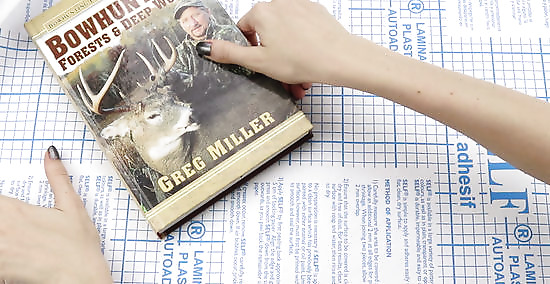
Roll out a sheet of the contact paper that is large enough for the book. Place the book on the contact paper. Center the book using the lines on the backing of the paper. If there are no guidelines, use a ruler. Think of this part as similar to wrapping a present.
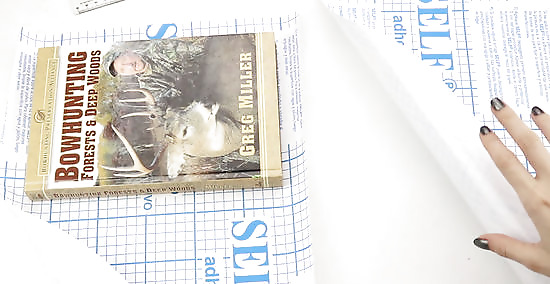
Cut the contact paper off the roll. Leave enough room when cutting so that you have enough paper to fold over the front cover. This will free the roll from the portion you’ll be working with. You should now have your book laying on top of a free, flat piece of plastic paper. There should be some excess paper around all sides of the book.
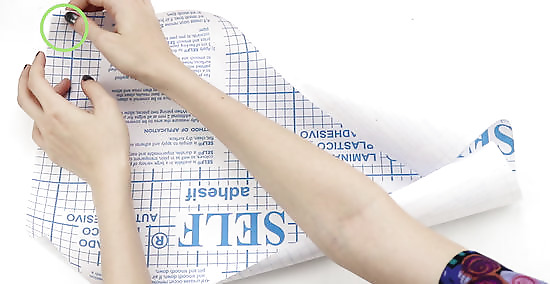
Remove the book from the contact paper. Peel the contact away from its backing if you need to. If you're using sticky contact paper that has a backing, you'll need to peel away the backing to reveal the adhesive side. When you lay the book back down, lay it on the adhesive side. The plastic will stick to the book.

Place the book back onto your plastic paper. Open the front cover of the book to bring a fold over of plastic paper. Bring your plastic paper over to the inside front cover of the book. You will want to apply a small piece of tape to hold the plastic in place. The repeat with the back cover. Don’t tape down the back cover yet.
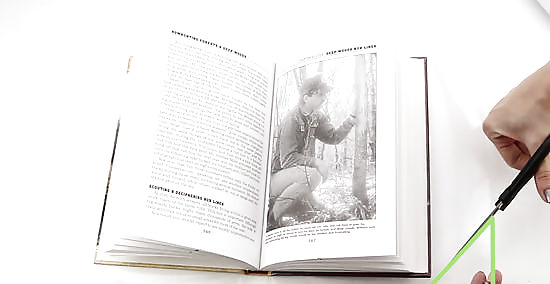
Cut out triangles in each corner of the contact paper. After you have folded the plastic over the corners you will have excess paper that needs to be trimmed and cut. First cut two slits in the plastic on either side of the book’s spine. Then, cut off the corners of the plastic from the top and bottom of your book. Cut at an angle so that your scissors go up to the corners of your book. You need to cut the corners so that you can easily cut away a layer of plastic inside the book covers. And fold down the extra plastic on the top and bottom of the book.
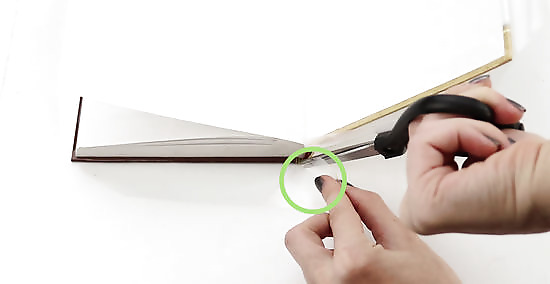
Cut away the top flap inside your covers. You will see flaps that are no longer connected to the parts of paper that are extending on the top and bottom of your book. Cut away these flaps so that you can easily fold down the extra plastic.
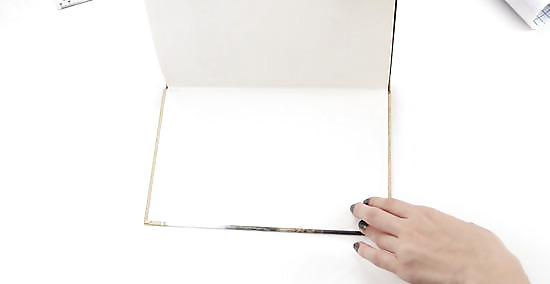
Lift the bottom of the book off the plastic paper, leaving the front cover flap in place. You want to lift the book to reveal the spinal tabs you cut. Then fold down the spinal tabs toward the center of the paper. Gently lower your book back down over the folded tabs.

Fold down the top and bottom portions of the paper. All that’s left to do is to open up your covers and fold the remaining parts of plastic paper into the inside covers. Try to tape the plastic together to hold everything in place without taping the book if possible. Tape can be hard to remove from the book, especially without causing damage. Check for air bubbles. Running a ruler across the cover usually dispels these. Then you’re all done.
Making a Fabric Book Cover
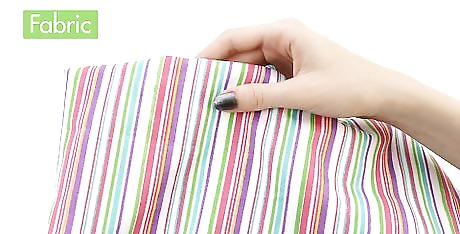
Grab your fabric. Use up a piece of fabric that is left over from another sewing project. Or make a special purchase of a fabric you just happen to like a lot. Either way, covering a book with fabric is a nice way to keep the book in good condition. Fabric can also add a personal touch that makes this book unique and special to you.
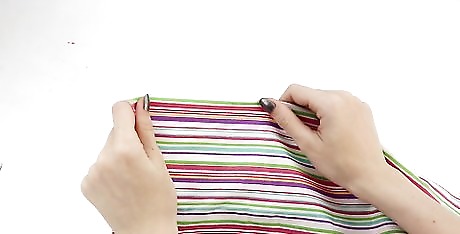
Choose the fabric. The fabric needs to be fairly substantial to protect the book, so avoid anything too flimsy. Also get some lightweight fusible interfacing. Fusible interfacing is used to add a rigidity or stiffness to a fabric. The interfacing gets applied to the wrong side of the fabric, or underside to help form your fabric.

Press the fabric. Take an iron and smooth out your fabric so that there are no wrinkles. Any wrinkles that you have when applying the fabric to your book will stay. Try using a fabric that is made to be wrinkle free to make covering your book easier.
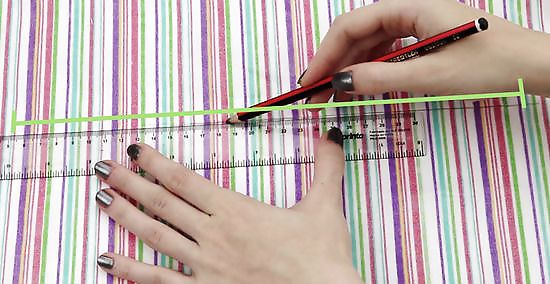
Measure the cover. Place the fabric down on a flat work surface. Center the book on the fabric. Make sure you have plenty of extra fabric. Draw two horizontal lines across the fabric along the top and bottom edges of the book. Extend the edges of the fabric beyond the book to provide adequate space for flaps on each side. For best results, make the flaps at least 2 inches/5cm wide. For larger books, add even more width. Leave a small allowance both above and below the horizontal lines when cutting.
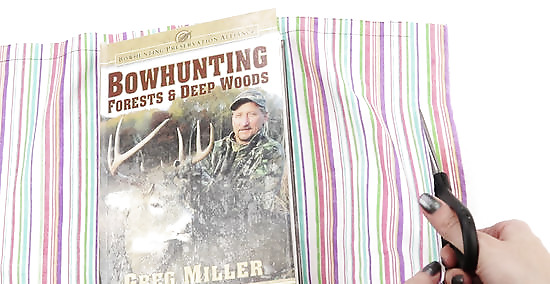
Remove the book from the fabric. Cut out the fabric to the new measurements, giving yourself more fabric than the dimensions of the book. You’ll want to give yourself some extra fabric to work with when cutting. Extra fabric also helps you to apply the fusible interfacing. When applying the interfacing, you’ll want to fold a small bit of the fabric over itself, around the interfacing.
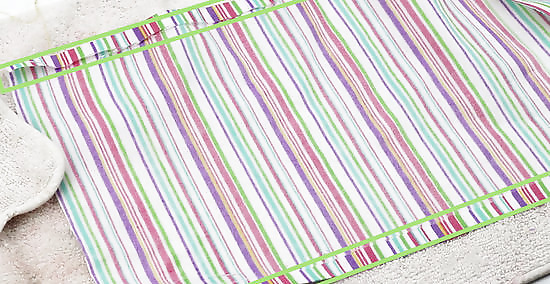
Fuse the interface to the wrong side of the fabric. This will be the side of the fabric that faces into the book. The fusible interfacing will have a bumpy side, the side that attaches to the fabric, and a smooth side. Press it into the fabric with a damp cloth. Then take your iron and iron it for 10 to 15 seconds. If you need to move the iron, pick it up and place it down in a new spot. Don’t glide it to heat another spot of the interfacing.
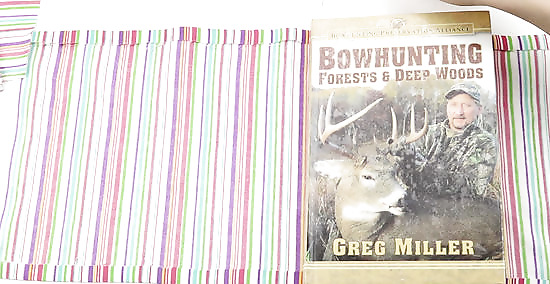
Place the book back onto the fabric. The interfaced side of the fabric should still be facing up. The interfacing isn’t meant to be shown. When you lay the book down, it will be against the interfaced side of fabric. This means that when you complete your cover, the interfacing will be inside and not exposed.

Open the front cover of the book. Lay the cover down and bring the left edge of the fabric in. You want to fold the left edge of the fabric over the book’s cover to create a sort of pocket. Then, using a pin, pin the flaps of fabric together. The top and bottom edges of fabric should extend past the edges of the book cover slightly. The extra fabric allows you to pin the fabric without pinning the book cover.
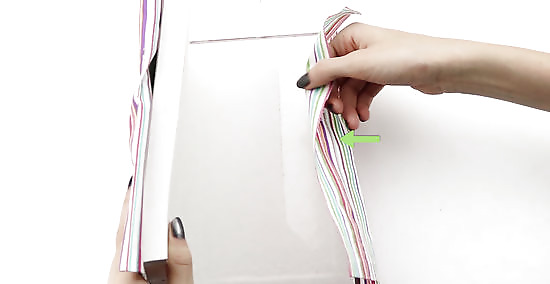
Open the back cover of the book. Fold the right edge of the fabric in over the cover. Repeat the same process for the other cover, pinning the flaps of fabric together.

Remove the book from the flaps. You will now have the general shape of your fabric book cover. Fold down any extra fabric that extended passed the vertical edges of the book covers. You want to fold in any extra fabric and pin it to the rest of the fabric.

Stitch the fabric together. Using a topstitch, sew across the top and bottom of the cover. A topstitch is a method of stitching that has you bringing the thread over the edges of your fabric layers. The stitch will then bring the layers together.
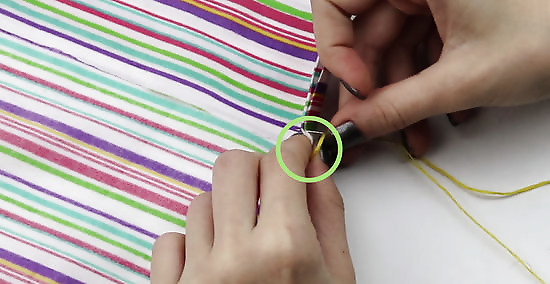
Capture the flaps or pockets as you sew. You will want to make sure to stitch all your flaps together. The top stitching will allow you to connect any flaps or pockets that have been folded over. The ultimate result will be one large pocket for you to slide your cover into. Do this for both sides. You should have two pockets, one for each cover stitched.
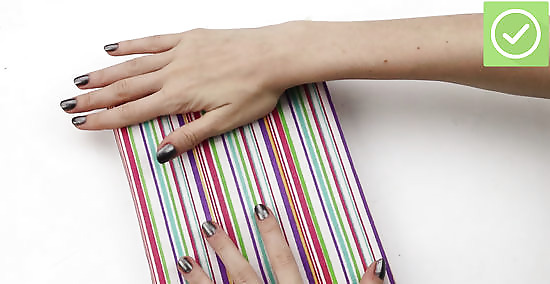
Slide the book into its cover. It's now ready for everyday wear and tear! You can also reuse this cover on any other book that is the same size as your original one.
Making a Felt Book Cover
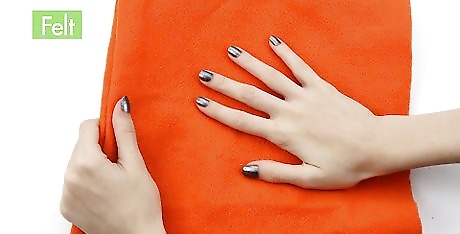
Use a colorful piece of felt to make a book cover. Felt is a strong and durable fabric to use for a book cover. It’s a good cover style for kids’ books or for notebooks that are toted around a lot in a bag. If you can, use wool felt in preference to synthetic felt mixes, as it’s a lot easier to work with. However, wool felt tends to be more expensive too.
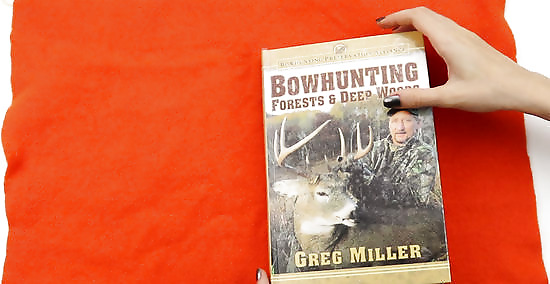
Use a piece of felt large enough for the book. An average dimension (paperback, notebook) is typically 8.5” x 12”/21.5cm x 30.5cm. Although you may need your felt to be larger depending on the size or your books. The sides of the felt need to be adequately large so as to fold over the edges of the book to create flaps.
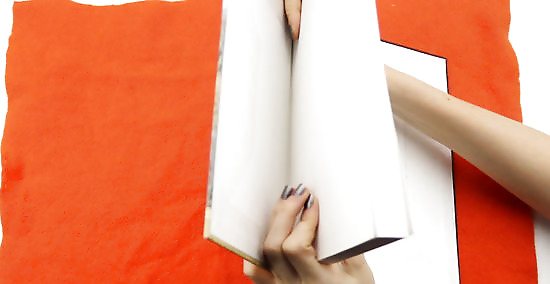
Lay the book on its spine. Fold the covers down. This will help you get an idea of how much felt you need. The book should be centered on the felt, and should be opened and sitting flat.
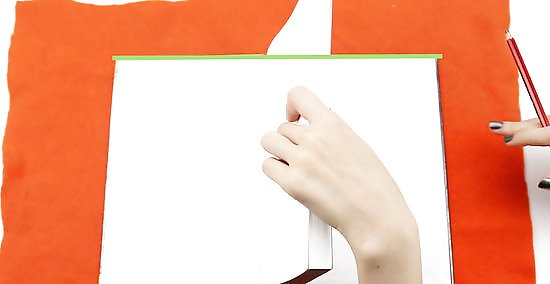
Trace the top and bottom of the book with a fabric pencil. This tracing will tell where to fold the felt for the top and bottom. Don’t trace the vertical edges as these parts will get folded in to create flaps. The extra width that extends past the vertical edges of the covers will turn into the flaps. If using the measurement for the felt provided above, this extra part should measure approximately 2 inches/5cm more each side. Also add a 1/4 inch/6mm edge above and below the marked horizontal lines. This will give you extra felt to cut or fold.
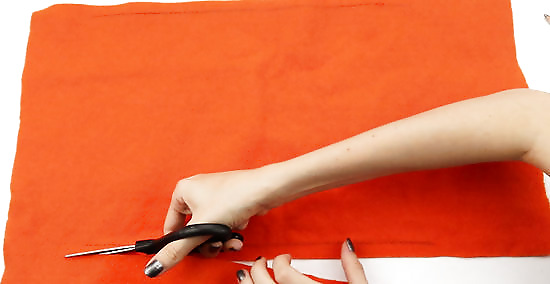
Cut the felt piece out. Lay it down flat on the work surface. You will now have a piece of felt that is slightly larger than your book.
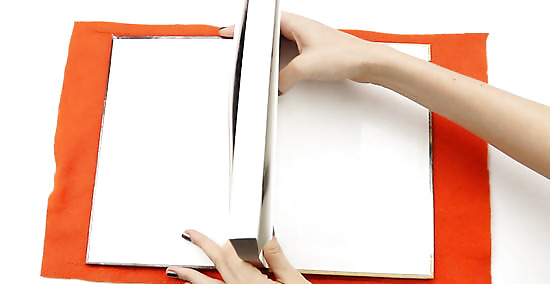
Place the book on the felt. Lay it on its spine and bring the covers down to lay on top of the felt. Center the book onto your fabric so that each edge has an even spacing between book and felt.

Fold the left vertical side of felt in. Take the portion of fabric that extends past your front your book cover and fold it over the cover. Pin The felt in place. You should have excess felt on the top and bottom of your book so that you pin only the felt and not the actual book. Repeat for the right side, pinning the felt in place. This creates the book flaps or slip pockets for your covers. Carefully remove the book from the felt. Slipping the felt off the book carefully without disturbing the pins.
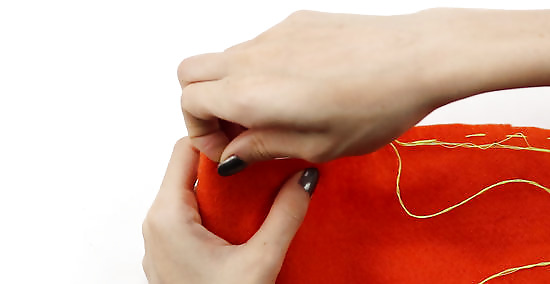
Stitch across the top and bottom of the felt fabric. Capture each side and fold in the stitching, as this is what keeps the slip pockets, or flaps, intact. You can either hand stitch or machine stitch, depending on the final look you're after.
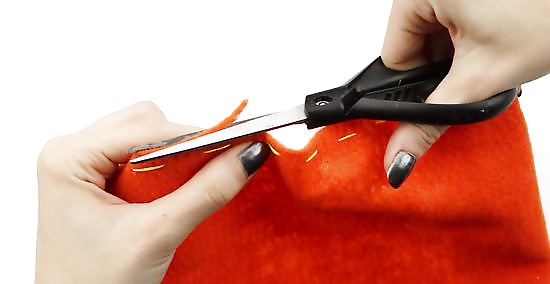
Trim off any excess felt above and below the stitching lines. Leave a small amount of felt above the stitching line, it's important not to trim too closely. Don’t cut too close to the stitching as you risk cutting the thread and unraveling your stitching.
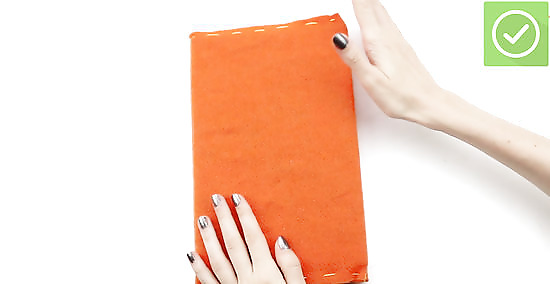
Slip the book into the flaps. Close it to make sure it sits tight. It should now be a well-protected book.

















Comments
0 comment